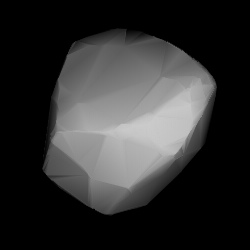Athalia, provisional designation 1903 ME, is a carbonaceous Themistian asteroid from the outer regions of the asteroid belt, approximately 40 kilometers in diameter. It was discovered on 20 September 1903, by German astronomer Max Wolf at the Heidelberg Observatory in southwest Germany. The asteroid was named after the ancient Judahite queen Athaliah.
Arago, provisional designation 1923 OT, is a dark asteroid from the outer regions of the asteroid belt, approximately 55 kilometers in diameter. It was discovered on 5 September 1923, by Russian astronomer Sergey Belyavsky at the Simeiz Observatory on the Crimean peninsula. The asteroid was named after French mathematician François Arago.
La Paz, provisional designation 1923 PD, is a carbonaceous asteroid from the outer region of the asteroid belt, approximately 40 kilometers in diameter. It was discovered on 31 October 1923, by German astronomer Max Wolf at the Heidelberg-Königstuhl State Observatory and named after the city La Paz in Bolivia.
1031 Arctica, provisional designation 1924 RR, is a dark asteroid from the outer region of the asteroid belt, approximately 75 kilometers in diameter. It was discovered on 6 June 1924, by Soviet−Russian astronomer Sergey Belyavsky at Simeiz Observatory on the Crimean peninsula. It was named for the Arctic Sea.
1033 Simona, provisional designation 1924 SM, is a stony Eoan asteroid from the outer regions of the asteroid belt, approximately 20 kilometers in diameter. The asteroid was discovered by George Van Biesbroeck in 1924, who named it after his daughter Simona.
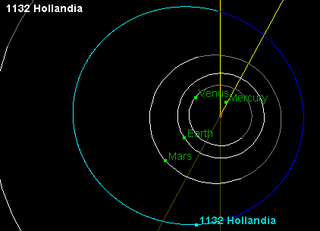
1132 Hollandia, provisional designation 1929 RB1, is a stony asteroid from the middle region of the asteroid belt, approximately 27 kilometers in diameter. It was discovered on 13 September 1929, by Dutch astronomer Hendrik van Gent at Leiden Southern Station, annex to the Johannesburg Observatory in South Africa. It was named for the region Holland in the Netherlands.
1815 Beethoven, provisional designation 1932 CE1, is a carbonaceous background asteroid from the outer regions of the asteroid belt, approximately 30 kilometers (19 miles) in diameter. It was discovered on 27 January 1932, by German astronomer Karl Reinmuth at the Heidelberg Observatory. The uncommon F-type asteroid seems to have a long rotation period of 54 hours (tentative). It was named after Ludwig van Beethoven.
1240 Centenaria, provisional designation 1932 CD, is a background asteroid from the outer regions of the asteroid belt, approximately 60 kilometers in diameter. It was discovered on 5 February 1932, by astronomer Richard Schorr at the Bergedorf Observatory in Hamburg, Germany. The assumed C-type asteroid has a rotation period of 11.3 hours. It was named for the 100th anniversary of the discovering observatory.
1532 Inari, provisional designation 1938 SM, is a stony Eoan asteroid from the outer regions of the asteroid belt, approximately 28 kilometers in diameter. Discovered by Yrjö Väisälä at Turku Observatory in 1938, it was later named for Lake Inari in northern Finland.
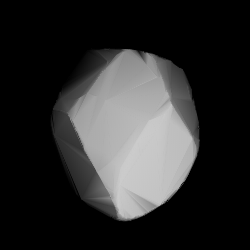
1281 Jeanne is a dark asteroid from the background population of the intermediate asteroid belt. It was discovered on 25 August 1933, by astronomer Sylvain Arend at the Royal Observatory of Belgium in Uccle, who named it after his daughter, Jeanne. The likely P-type asteroid has a rotation period of 15.2 hours and measures approximately 22 kilometers in diameter.
3754 Kathleen, provisional designation 1931 FM, is a large background asteroid from the outer regions of the asteroid belt, approximately 55 kilometers in diameter. It was discovered at the Lowell Observatory near Flagstaff, Arizona, on 16 March 1931, by American astronomer Clyde Tombaugh, who named it after his granddaughter Kathleen Clifford. The assumed C-type asteroid has a rotation period of 11.18 hours. It is the second-highest numbered main-belt asteroid larger than 50 kilometers.
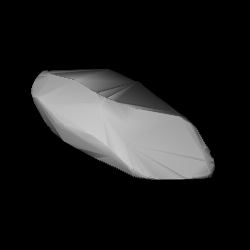
2094 Magnitka (prov. designation: 1971 TC2) is a Flora asteroid from the inner regions of the asteroid belt, approximately 12 kilometers (7.5 miles) in diameter. It was discovered on 12 October 1971, at and by the Crimean Astrophysical Observatory in Nauchnyj, on the Crimean peninsula. The discovery has not been attributed to an observing astronomer. It was later named for the city of Magnitogorsk.

4547 Massachusetts is a dark background asteroid from the central regions of the asteroid belt, approximately 24 kilometers in diameter. It was discovered on 16 May 1990, by Japanese astronomers Kin Endate and Kazuro Watanabe at the JCPM Sapporo Station on the island of Hokkaido, Japan. The asteroid was named for the U.S. state of Massachusetts.

1356 Nyanza, provisional designation 1935 JH, is a dark asteroid from the background population of the outer asteroid belt, approximately 63 kilometers in diameter. It was discovered on 3 May 1935, by South-African astronomer Cyril Jackson at the Union Observatory in Johannesburg. The asteroid was named for the former Nyanza Province in Kenya, Africa.
1426 Riviera, provisional designation 1937 GF, is a bright asteroid from the central regions of the asteroid belt, approximately 16 kilometers in diameter. Discovered by Marguerite Laugier at the Nice Observatory in 1937, the asteroid was later named for the Côte d'Azur, also known as French Riviera.
2013 Tucapel, provisional designation 1971 UH4, is an eccentric Florian asteroid from the inner regions of the asteroid belt, approximately 11 kilometers in diameter. It was discovered on 22 October 1971, by the University of Chile's National Astronomical Observatory at Cerro El Roble Astronomical Station. It was named for one of the indigenous Mapuche chiefs.
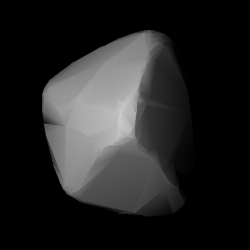
2120 Tyumenia is a dark background asteroid, approximately 45 kilometers in diameter, located in the outer regions of the asteroid belt. It was discovered on 9 September 1967, by Soviet astronomer Tamara Smirnova at the Crimean Astrophysical Observatory in Nauchnyj, on the Crimean peninsula. The asteroid was named for the now Russian district of Tyumen Oblast in Western Siberia.
1397 Umtata, provisional designation 1936 PG, is an asteroid from the background population of the asteroid belt's central region, approximately 21 kilometers in diameter. It was discovered by South-African astronomer Cyril Jackson at the Union Observatory in Johannesburg on 9 August 1936. The asteroid was named after the South-African town of Mthatha, formerly known as Umtata.
1585 Union, provisional designation 1947 RG, is a dark background asteroid from the outer regions of the asteroid belt, approximately 52 kilometers in diameter. It was discovered on 7 September 1947, by South African astronomer Ernest Johnson at the Union Observatory in Johannesburg, South Africa. The asteroid was named after the discovering observatory.
1466 Mündleria, provisional designation 1938 KA, is a carbonaceous asteroid from the inner regions of the asteroid belt, approximately 22 kilometers in diameter.
